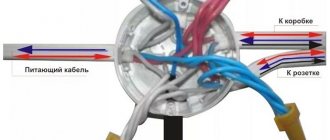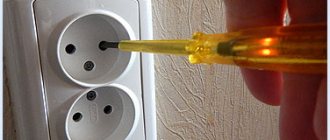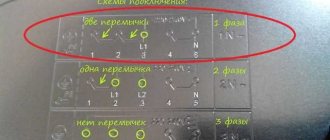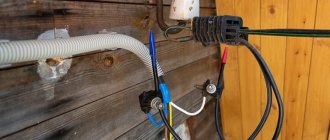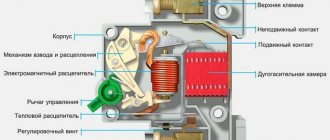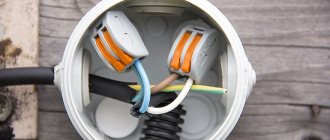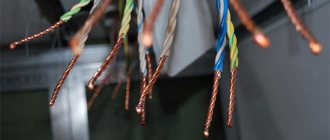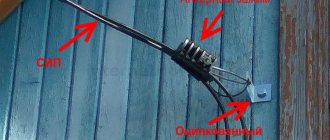When planning energy supply at a facility, one of the important issues is saving materials. Laying a separate power line from the circuit breaker to each consumer is irrational, so nodal points and branching wires are made on the power main. Each additional connection requires the installation of a junction box.
What is a distribution (junction) box
This is an electrical product, which is a closed housing made of metal or dielectric material. The second option is preferable, provided that the material is sufficiently reliable from a fire safety point of view. That is, it must be non-flammable, or at least not support combustion.
Inside, power cables and supply wires are connected for consumers or switching devices. The junction box must provide protection for internal connections from dust, moisture, and foreign objects. In addition, the product prevents accidental contact with exposed areas of the electrical circuit (current-carrying busbars, contacts).
The shape of the box, as well as its dimensions, are not regulated - the format of the product is selected based on the installation conditions. However, manufacturers adhere to certain standards for compatibility with various fittings and components.
Types of distribution boxes
Based on the body material, boxes are divided into:
- Metal - for installation in rooms built from flammable materials (wood, plastic), or on walls insulated with flammable material. They may have a dielectric layer inside to reduce the likelihood of unauthorized contact closure.
- Plastic are the most common due to their low manufacturing cost. They are made either from non-flammable material, for use in conditions of high fire danger, or from materials that do not support combustion. That is, the junction box in any design should not become a source of fire, even if the wiring ignites inside.
According to installation conditions:
- For indoor installation. Designed for installation in walls and cladding. They consist of a body, which must be firmly held in the supporting structure, and a flat cover. In turn, the cover must be removable for access to the contact group or twists. In such boxes, the thickness of the case can be thinner, because it does not bear the structural load.
As a rule, built-in boxes are made in a round shape. When installing into a monolithic wall, drilling an installation hole using a crown is much easier. For installation in drywall, you can use rectangular (square) housings. It is easy to cut such a hole in the gypsum board.
From the point of view of connecting wires, it is more convenient to work with a square (rectangular) case. - For outdoor installation (non-sealed) - conditions of use - indoors or closed cabinets. The housing is both protection from the external environment and a strength element of the structure. Therefore, it must be thicker and stronger.
To prevent foreign objects from getting inside, the outer boxes are equipped with sealing clamps for wires. - For outdoor installation (sealed). Installation of the distribution box outdoors involves direct exposure to water, frost, and fog. Since water is a conductor, the inside of the housing must be dry. Therefore, sealed boxes have a rubber seal along the sealing contour of the lid, and crimp (collet) clamps for inserting wires.
- Of course, additional equipment of products (moisture protection, etc.) increases the cost. Therefore, when choosing a package, we usually proceed from the principle of reasonable sufficiency.
Junction boxes can be equipped with a ready-made set of connectors for wires. Or you buy an empty case, and the fittings are selected separately.
Detection using a metal detector
Buildings built before the 1990s often used metal junction boxes, which can be effectively detected by metal detectors under thick layers of plaster or decorative trim. Manufacturers make many different types of metal detectors with numerous features. One of the most popular among installers is the “Floureon” universal device. With its help, you can not only identify hidden metal objects, live wires at a depth of up to 10 cm, but also wooden logs, plastic pipes and other objects. For information on various wire connections in a junction box, read the article: “Wire connections in a junction box? DIAGRAMS”, as well as “Modern methods of connecting wires” .
The device has three operating modes:
- Live wire detection, switch center position;
- Metal element detection, right switch position;
- Detection of wooden, plastic pipes and other objects different in structure and density from the building material of the wall, left switch position.
The switch is located on the front panel in the center of the case under the LCD display. On the left side there is a button to calibrate the device, which must be pressed before testing. To calibrate, the device is applied to a section of the wall where there are no foreign objects, the button is pressed, a sound signal appears, after a few seconds the display shows information about the successful completion of calibration, the signal disappears. In this process, the structure of the material of a clean wall is read; with any change in density, the presence of metal objects, or a magnetic field from electrical wiring, the “Sensor” automatically detects these signs and displays information on the display. Symbols displayed on the screen:
- A triangle with lightning indicates the presence of AC live wires;
- A horseshoe magnet indicates the presence of metal objects;
- A crossed out magnet or channel outline indicates the presence of wooden or plastic structures.
To search for a box, the device is set to metal detection mode. This method has a number of disadvantages; metal structures in plasterboard and concrete walls with reinforcement make searching difficult.
Appearance of the Bosch GMS-120 detector
Analogues of such devices are produced by many manufacturers; the Zubr and Bosch GMS-120 models are actively used; they are not cheap and only justify themselves in professional activities.
Comparison table of technical characteristics of various models
| Brand | Detection objects | Detection depth in mm Steel/copper | Wire detection depth in PVC insulation, mm | Detection depth of wooden blocks, mm | Accuracy in mm |
| GMS 100M | Ferrous and non-ferrous metals, wires | 100/ 80 | 51 | — | 1,1 |
| GMS 120 | Metals, wires, wood elements | 120/80 | 51 | 39 | 1,1 |
| D-tect 120 | Non-ferrous and ferrous metals, cables, plastic and wood | 120/80 | 61 | 39 | ±11 |
| D-tect 150, D-tect 150 SV | Metals, wires, plastic, wood. | 150/80 | 61 | 41 | ±6 |
The Bosch GMS-120 costs approximately 6,700 rubles; not every average person can afford to purchase such a device for temporary use.
Where can I buy
You can resolve the issue as quickly as possible by visiting the nearest specialized store. The optimal option, in terms of price-quality ratio, remains purchasing from the AliExpress online store. Mandatory long waits for parcels from China are a thing of the past, because now many goods are in intermediate warehouses in destination countries: for example, when ordering, you can select the “Delivery from the Russian Federation” option:
| 3-pin waterproof distribution IP68 box | Distribution box, IP67 housing | Junction box, IP65 |
| 3-way distributor box, IP68 | Distribution box 2/3/4/5/6 way, IP68, 45A/450V | Mini junction box IP66, size 47*28*18mm |
Simple industrial devices for detecting wiring
Many manufacturers make wiring detection indicators with various additional functions; let’s consider the simplest and most accessible for the average consumer working at the household level:
- Indicator screwdriver with autonomous power supply on button-type batteries and LED as an indication. To determine the route of the wires, just take a screwdriver by the metal end of the pen and move the handle along the wall; when guidance appears, the LED will light up.
The brightness of the glow depends on the proximity to the wire; the calculation of the box is also done by searching for places where the lines converge and tapping. The accuracy of detecting wires under plaster is up to 3 - 5 cm. Such a screwdriver costs up to 100 rubles.
- The universal screwdriver has three operating modes, “O” - determining the phase in the circuit by simply touching the bare end of the conductor with a pen. In “L” mode, the indicator non-contactly indicates the presence of a live wire at a distance of 1.5 cm.
Mode “H” reacts with increased sensitivity to the magnetic field of the conductor of hidden wiring at a depth of up to 3 cm. The cost of universal indicator models depends on the number of options and manufacturer: 200 - 300 rubles.
- domestically produced hidden wiring indicator “Woodpecker”
Sensitivity interval from antenna to live wire in mm
| range 1 | 10 mm. |
| range 2 | 100 mm. |
| Range 3 | 150 mm. |
| range 4 | 700 mm. |
The first is low, the most accurate detects a hidden wire at a distance of 1 - 1.5 cm, in the fourth mode the detection accuracy is up to 3-4 cm.
Appearance of controls and indications of the Woodpecker detector
The presence of an electric field in the conductor is indicated by an indicator LED and an audible buzzer. To test, press and hold the corresponding mode button while moving the tip of the antenna along the surface of the wall. The simplest Woodpecker model costs about 800 rubles.
To detect a junction box, when using any device, the intersections of lines are identified.
Layout
To begin, make a flowchart that makes it clear which consumer groups need to be created. Then the power on each branch is calculated.
There are two methods of load distribution:
- Interior. An introductory (basic) box is organized in each room. Power lines are laid from the base points to the input distribution board. Each line is started on a separate machine. In the case where powerful electrical equipment (boiler, air conditioner, electric stove) is installed in some rooms, a separate line of power sockets is laid. Then the basic distribution box is disconnected for each consumer in the room. For this purpose, additional junction boxes can be installed. An approximate diagram of the basic boxes looks like this:
- By consumer groups. Separate lines are laid for the lighting of all rooms, for the low-load socket network (TV, computer, table lamps), and for the power socket network. These wires are also connected to the circuit breakers of the input panel. Again, distribution boxes are installed along each line at the tapping points to individual consumers.
Next comes the dirty work: actually installing the boxes and laying the cable lines.
Hidden installation
Wiring is laid between the nodal points (where the boxes are installed). Since the installation is hidden, the walls are grooved for the cable, and the boxes are installed on alabaster. The prepared wires are removed from the installed boxes for connection. The length of the free ends should provide the possibility of connection without interference, and allow for 2-3 alterations (with cutting off the used conductors).
The method of connection does not matter (soldered twist in the illustration), the main thing is to understand the principle itself. For cables, the flush-mounted boxes have marked holes. In this case, tightness is not required; there will be a wall and plaster around it. The secret is that alabaster, diluted to a creamy consistency, when installing the box, fills all the cracks, grooves and extra holes.
The result is a monolith with dielectric walls. The planting depth is calculated taking into account the thickness of the wallpaper and the shape of the lid.
Outdoor installation
The principle of connecting the wiring is the same, but the installation is done differently. First, the junction boxes are installed, then the external cable is connected to them. Since the housing provides protection from dust and moisture, the cables are routed inside using sealing clamps.
For outdoor installation, collet clamps are used.
The wires must be color-coded: in single-phase versions, zero, phase, and protective grounding. It is not possible (especially before connecting the ends of the cable) to hang tags indicating the purpose of the wires. After final installation, it is enough to record the purpose of the wires on the diagram. You can stick short symbols on the inside of the cover for ease of further maintenance.
If the methods of how to disconnect a distribution box on a power line are clear: we simply connect the input and output wires by color, then connecting a switch is a completely different scheme.
Various ways to connect switches and lighting fixtures
- Classic connection using a junction box.
The neutral and phase wires are inserted into the box. For simplicity, we will leave protective grounding out of brackets. The neutral wire is directly connected to the lamp. The phase is supplied to the switch, then transits through the box and connects to the second input of the lamp. From an installation point of view, 3 two-core wires enter the junction box. Using the same principle, two or three-key switches are connected. Only more transit phase wires (from keys to lamps) will pass through the box. If you connect several lamps to one switch, there is no point in installing several distribution boxes. You can connect lamps in parallel, starting from the first lamp. In this case, the switch will be a group switch. - Wiring for a lamp without junction boxes.
In this case, a power cable is inserted from the nearest distribution box into the switch housing. The neutral wire is connected to the lamp directly, and the phase wire is opened by a switch. On the one hand, this saves one box. On the other hand, the cable is laid irrationally and must be inserted into the switch housing from below or from the side. While according to the standard generally accepted scheme, the main line runs along the ceiling. And from the ceiling junction boxes, the wiring goes down to the sockets or switches.
Why are they called differently?
The electrical connection box has received several names at once - distribution, junction, branch, switch.
It is like an electrical distribution point, which receives voltage from a power source, and then disperses along several electrical branches - to sockets, switches, and lighting fixtures. Because the voltage in the box is distributed in different directions, it is called distribution. Since several electrical branches extend from the box, a synonym has appeared - branch.
Another name comes from the way the wires are connected inside the box. For a long time, soldering was considered the most reliable method. At the junctions, the wires were twisted and then soldered, due to which electricians began to call the boxes unsoldered.
In an interesting way, another synonym arose - exclusion box. The word “disconnection” can only be heard among professional electricians, and they came up with it, as if combining two concepts - distribution and connection. That is, they distributed in the box which wire should go where, and then connected them according to the diagram.
Now there are so many modern connection options - all kinds of terminal blocks, welding, insulating connecting clamps, sleeve crimping, terminal blocks, self-clamping terminals. However, boxes are still often referred to as breakout boxes.
We explained all this to you so that when you go to choose materials in electrical goods stores and see different names in different places, know that they all mean the same junction box.
Methods for connecting wires in junction boxes
Putting the wires inside the box is half the battle. Now you need to choose a connection that is reliable and easy to maintain.
All cable line connections are divided into two main categories:
- Detachable, that is, the wiring can be disconnected and reconnected many times, without critical damage to the wire or connecting device. For example, a screw connection on terminal blocks.
- One-piece, that is, when the conductors are separated. the connection is destroyed. There is no big problem with this, it’s just that the cable gets shorter each time, and the connecting devices have to be purchased again.
The type of splicing when disconnecting boxes is selected based on the design of the overall network. If you plan to periodically disconnect one or two branches from a common box, it is better to choose a screw connection or reusable quick-release terminals.
For permanent connections that will not be dismantled for many years, the same terminals are used, only for one-time use. Despite the obvious drawback: the impossibility of reuse, such terminals provide more reliable contact compared to reusable ones.
Important! The listed methods allow you to install cables using different conductors: for example, aluminum and copper. In this case, the metals do not touch, and electrocorrosion does not threaten loss of contact.
If you use only copper conductor both in the backbone network and in subscriber branches, there are cheaper ways to permanently connect the wires:
- Twisting with welding. Creates reliable contact, without the risk of sparking and heating of the wiring under heavy load.
The connection is simple, but requires special equipment. As a last resort. You can melt the copper tips with a portable gas torch. - Twisting with soldering. It is not as reliable as with tip reflow, but when using refractory solders, the connection practically does not lose strength, even when heated.
The advantage is accessibility. A powerful soldering iron is easier to find than welding equipment. The basic rule: strength is ensured by twisting; we simply fill the voids with solder, improving contact. - Twisting with mechanical fixation (crimping). A questionable method, since there is a possibility of damage to current-carrying wires.
- There is nothing to say about ordinary twisting: although it is not prohibited, this technique is practically not used.
Direct connection (disconnection)
Is it possible to organize electrical wiring without junction boxes? When branching no more than 2 lines, it’s easy. Several conditions must be met:
- If the connection is made by twisting, soldering with refractory solder is required. Crimping can be used.
- "T" shaped connections are undesirable; it is better to make a "Y" shaped branch.
- After connecting and checking the quality of contact, the splice area must be carefully insulated and protected from moisture. Especially if the connection is made in hidden wiring (plaster wall) or on the street.
